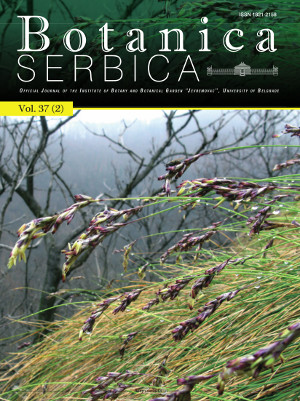
Volume 37 Issue 2 2013 |
Grassland bryophyte assemblages of Fruška Gora Mountain (Serbia)
|
KEY WORDS: bryophytes, ecology, grasslands, Fruška Gora, Vojvodina, Serbia |
Variations of essential oil characteristics of Clinopodium pulegium (Lamiaceae) depending on phenological stage
|
The essential oils were obtained from aerial parts of the plants by hydrodistillation and analyzed by GC-MS. These are the first data on the essential oil characteristics of plants of the population from the Svrljiški Timok gorge. Samples originating from both natural and cultivated populations were characterized by high amounts of essential oils in all stages of development (0.8% - 1.4%). Twenty-one compounds were identified, representing 95.3-99.6% of the total oils. Differences in the essential oil composition were more quantitative than qualitative. The quality of the essential oil was stable and did not vary with differences in environmental conditions. Dominance of the main components was modified by phenological stage. Pulegone was dominant in the vegetative (76.1% wild population, 62.7% cultivated population) and the flowering (49.5%, 64.6%) stages, while menthone (48.5%, 65.3%) displaced pulegone (34.7%, 18.4%) at the fruiting stage. Cultivated plants in the vegetative and flowering stages can be considered a significant source of pulegone, and in the fruiting stage a significant source of menthone. Careful selection of the developmental stage of the plant is a potential tool which could be employed to obtain the preferred chemical composition of C. pulegium for commercial use KEY WORDS: Clinopodium pulegium, essential oil, pulegone, menthone, phenological stage |
Reynoutria sachalinensis:a new invasive species to the flora of Serbia and its distribution in SE Europe
|
KEY WORDS: Invasive species, first record, range extension, Reynoutria sachalinensis, Serbia, Balkan Peninsula |
Sesleria serbica(Poaceae), a neglected species of the Balkan Peninsula
|
KEY WORDS: Sesleria serbica, Poaceae, neglected species, morpho-anatomy, ecology, chorology |
Histoanatomical study on the vegetative organs of Tradescantia spathacea(Commelinaceae)
|
KEY WORDS: histoanatomical study, leaf, root, stomata, stem, Tradescantia spathacea |
Variations in essential oil yields and compositions of Salvia officinalis(Lamiaceae) at different developmental stages
|
Also, based on these analyzes showed that the same individual (the same genotype) during one growing season significantly change the chemical composition of the essential oils. Thus, it is possible to distinguish three different “phenological types of essential oils”: young leaves (“yl-oils”), early old leaves (“early-ol-oils”) and a late old leaves type (“late-ol-oils”). Analysis of the seasonal changes in the composition of the essential oils of Dalmatian sage is shown that different components have different dynamics and different directions of change in the concentration during the season. KEY WORDS: Salvia officinalis, essential oil, camphor, thujone, a-humulene, developmental stage |
Notes on some rare and interesting bryophytes of Slovenia
|
KEY WORDS: bryophyte, flora, mosses, liverwort, rare, Slovenia |
Additions to the cytology of Saxifraga(Saxifragaceae) from the Western Himalayas, India
|
KEY WORDS: cytomixis, meiotic abnormalities, Saxifraga, Western Himalayas. |
Effect of temperature and media supplements on slow growth conservation of medicinal plant Spilanthes acmella
|
Slow growth treatments significantly improved survival with maximum percent survival on MS+2% mannitol at 15±2°C at the end of 8 months. Of the two temperatures, 15±2°C gave a significant reduction in growth. Cultures stored at 26±2°C did not survive more than 5 months. Among different treatments, 2% mannitol followed by 2% sorbitol proved effective in slowing growth of the cultures in terms of shoot number and length. Half MS salts and addition of ABA to the media did not result in slowing down growth. Moreover, shoot number, length and leaf number decreased with increase in the storage duration. Re-growth with maximum percent survival was observed in plants stored on MS+2% mannitol at 15±2°C. However, higher concentrations of osmotic agents proved deleterious for survival as well as re-growth of the plants KEY WORDS: Spilanthes, slow growth, conservation, osmotic agents, temperature, storage |
The effect of temperature and light (PAR) on the induction of Chla fluorescence in situ. 2. Diurnal changes in stinging nettle (Urtica dioica) and red currant (Ribes spp.)
|
KEY WORDS: Spilanthes, slow growth, conservation, osmotic agents, temperature, storage |
On the distribution of Goniolimon tataricum (Plumbaginaceae) in Serbia
|
KEY WORDS: Goniolimon, distribution, ecology, Serbia |
Novelties for vascular flora of Bosnia and Herzegovina
|
KEY WORDS: Floristic novelties,distribution, threatened status, Bosnia and Herzegovina. |
Dr. Rajna Jovanović |


